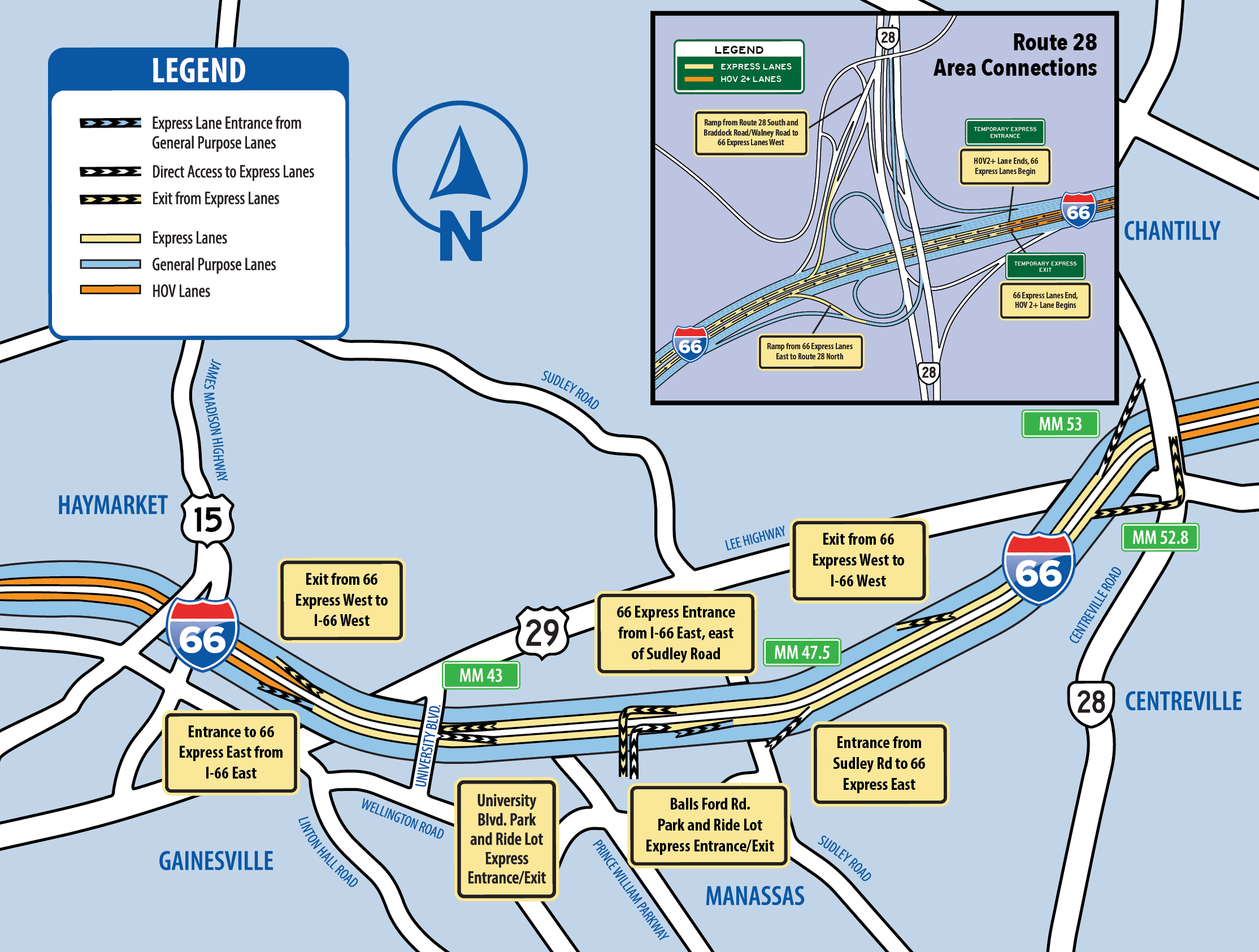A stretch of Virginia’s long-anticipated 66 Express Lanes are open for business, but there are a few things drivers should be aware of before taking advantage of them.
The westernmost stretch of the 66 Express Lanes welcomed their first commuters ahead of schedule last week, offering a more streamlined drive from U.S. Route 29 in Gainesville to Va. Route 28 in Centreville.
The 9-mile segment is free of charge for now, according to the Virginia Department of Transportation, granting drivers a chance to familiarize themselves with the new entry and exit points before an eventual shift to electronic tolling.
That grace period will be especially handy for drivers unaccustomed to using express lanes with limited exits. The idea works much the same as current express lanes along the Capital Beltway and Interstate 95 elsewhere in Northern Virginia, but for those wanting an explainer — or a refresher — we’re here to help.
Need a visual aid? WTOP’s Dave Dildine toured the eastbound and westbound express lanes between Gainesville and Centreville after their opening this week:
This video is no longer available.
Eastbound drivers entering the new express lanes in Gainesville and Manassas are committed until reaching their end at Route 28 — where construction continues on the rest of the express corridor, tentatively opening this December.
At that point, eastbound travelers wanting to head northbound onto Route 28 have the option of either taking an exit to Route 28, or funneling into the I-66 main lanes at the I-66/Route 28 interchange.
Eastbound drivers on I-66 have three opportunities to join the express lanes as it stands: At their origin before Route 29, via a slip ramp along the left side just east of the Sudley Road overpass, or from northbound Sudley Road on a flyover that splits from the eastbound ramp before reaching the general purpose lanes. There is also eastbound access from Balls Ford Road and University Boulevard.
Keep in mind that if you join the eastbound express lanes at any point, you’re with them all the way to Route 28.
Westbound drivers can enter the express lanes from the left side just beyond Va. Route 286/Fairfax County Parkway. Unlike the opposite direction, westbound travelers currently have a few opportunities to exit the express lanes mid-route instead of running the full nine-mile stretch.
Near the Manassas Rest Area, drivers headed to Sudley Road or the Prince William Parkway can use a flyover ramp to rejoin the I-66 general purpose lanes before leaving the highway. Signage for this ramp bills it as a “local” exit.
Westbound drivers will then encounter two new exits in Manassas and Gainesville. The first, exclusive to the express lanes for now, links with Balls Ford Road and a large park-and-ride lot after Sudley Road.
A second exit connects westbound travelers with University Boulevard soon after the Prince William Parkway. That exit takes drivers directly to Route 29.

Drivers with experience using Northern Virginia’s other express routes will probably find the new 66 Express Lanes familiar. On-ramps and exits are limited compared to general purpose lanes.
“The main-to-express exchange in Manassas is a lot like the one on I-395 near Edsall Road and, like the 395 Express Lanes, which only have a few dedicated ramps to Seminary Road and the Pentagon, the exits are limited,” Dildine said. “In this way, the express lanes are similar to the others in Northern Virginia.”
It’s free for now, but it won’t be forever. Tolling, once implemented, will vary in real-time. Overhead signs placed ahead of entryways will flash a dynamic toll rate that fluctuates with demand. Electronic toll gantries will log each vehicle’s distance traveled and charge solo drivers through their E-ZPass according to the rate at their time of entry.
Drivers with at least one passenger will be able to continue using the express lanes for free as long as they’re equipped with an E-ZPass Flex set to carpool mode. But that requirement will be upped to two passengers plus the driver once the remaining 66 Express Lanes open later this year, mirroring high-occupancy vehicle rules along the Capital Beltway, I-395 and I-95.
Commuters will pay the same rate regardless of vehicle type, with one notable exception that sets the 66 Express Lanes apart from the rest: Large trucks, barred from the area’s other express routes, will be granted access at a higher charge. Motorcycles can ride toll-free without an E-ZPass.
Confused? We don’t blame you. It’s a lot to soak in for someone not already used to the concept of express lanes, and that’s exactly why VDOT is giving drivers a chance to grow acquainted with the new pattern before debuting tolls. Think of it like a free trial — and if you don’t already have an E-ZPass or E-ZPass Flex, now is a great moment to sign up for one.
“Enjoy the free ride while it lasts,” Dildine said. “We don’t yet know how high the tolls for solo drivers will be, so now is a good time to acclimate to the flow.”
Work is wrapping up on the route’s eastern half, set to open come December. That stretch will offer more exit options for eastbound drivers past Route 28, including dedicated ramps to Monument Drive, Va. Route 123, Vaden Drive and the Beltway’s own express lanes.
But for the next few months, we’re all eyes on the nine miles between routes 28 and 29 for a sense of how the rollout is going.
“When afternoon traffic is heaviest, there is a little weaving in Manassas where the local flyover ramp meets the right exit lane for Sudley Road, but the backup hasn’t been too impactful yet,” Dildine said, noting that drivers “seem to be enjoying the higher speed limit, which is a non-variable 70 miles per hour posted.”








